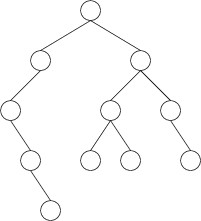Binary Trees
Binary Trees
A binary tree is a tree in which each node has exactly two children, either of which may be empty. For example, the following is a binary tree:
Note that some of the nodes above are drawn with only one child or no children at all. In these cases, one or both children are empty. Note that we always draw one child to the left and one child to the right. As a result, if one child is empty, we can always tell which child is empty and which child is not. We call the two children the left child and the right child.
We can implement a single node of a binary tree as a data structure and use it to store data. The implementation is simple, like the implementation of a linked list cell . Let’s call this type BinaryTreeNode<T>, where T will be the type of data we will store in it. We need three public properties:
- a Data property of type T;
- a LeftChild property of type BinaryTreeNode<T>?; and
- a RightChild property of type BinaryTreeNode<T>?.
We can define both get and set accessors using the default implementation for each of these properties. However, it is sometimes advantageous to make this type immutable. In such a case, we would not define any set accessors, but we would need to be sure to define a constructor that takes three parameters to initialize these three properties. While immutable nodes tend to degrade the performance slightly, they also tend to be easier to work with. For example, with immutable nodes it is impossible to build a structure with a cycle in it.
